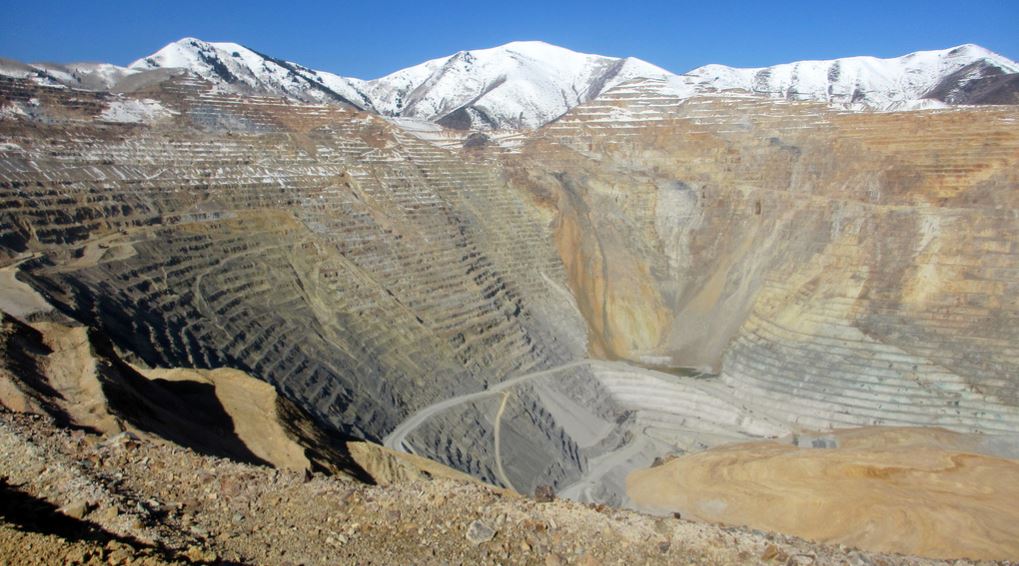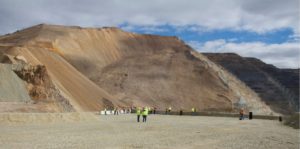Three years ago, Rio Tinto Kennecott launched a seven-year project to rehabilitate the mountainside altered by decades of mining.
Three-hundred-fifty tons of rock, and $150 million later, the effort to reshape the east-facing, waste-rock piles on Salt Lake Valley‘s western edge is bringing some green to the area.
Rio Tinto Kennecott continues to reclaim waste rock piles on the lower-outer face of the Bingham Canyon Mine as part of their Alternative View Project. The project will enhance the aesthetics of historic waste rock dumps visible from the Salt Lake Valley, and broaden the options for future reuse or additional mining.
Kennecott has spent $150 million on the project since it began in 2015. As part of the project, Kennecott has moved approximately 350 million tons of waste rock to reshape, regrade and seed 400 acres. Kennecott has also finished constructing 35 stormwater detention basins to manage surface water runoff from the mine’s face. Each of these basins is designed to manage a 100-year, 24-hour rain event.
“This is an important project because it provides environmental benefits and helps meet our community’s expectations,” said senior project manager, Zeb Kenyon. “Concurrent reclamation will continue to be an important part of our environmental commitment as we mine in the future.”
Kennecott has a 25-year history investing in concurrent reclamation, or reclaiming land that is no longer needed for the operation while mining continues. As part of that history, Kennecott has restored more than 11,500 acres of land impacted by historic mining operations and spent more than $500 million in reclamation and remediation efforts.
On June 22, 2018, Rio Tinto Kennecott officials led a tour to show-off the progress of their ecological restoration work at the Bingham Canyon Mine — one of the world’s largest copper mining operations.
Here’s what Rio Tinto Kennecott says about their mine reclamation efforts:
Prior to Rio Tinto’s purchase of Kennecott in 1989, predecessors mined and smelted in the Oquirrh Mountains leaving behind wastes. Most of the companies that produced the wastes have long been out of business. We now own almost all of the historic mine properties along the Oquirrh Mountain Range where our predecessors deposited these wastes.
Consequently, cleanup work has been a constant activity for us since the early 1990s. To date, we have spent more than $400 million to clean up historic mining wastes and install pollution source control measures. The cleanup efforts resulted in approximately 26 million tons (16.25 million cubic yards) of mining wastes being isolated, excavated, relocated, disposed of and/or permanently stabilized in place.
We have excavated 10 million tons (6.25 million cubic yards) of clean materials to support the cleanup work. Additionally, we have restored, reclaimed or re-vegetated more than 3,340 acres of land, including approximately 1,000 acres of new wildlife habitat or open space. We have planted more than 120,000 trees, as well as several thousand acres of shrubs, forbs and grasses.
Notably, our cleanups have met or exceeded regulatory requirements and, we believe, fulfilled community expectations. We performed this work in coordination with the US Environmental Protection Agency (USEPA) and the Utah Department of Environmental Quality (UDEQ), as well as with review by other interested parties.
The Daybreak development is example of how successful remediation efforts on land previously used for mining purposes can lead to new beneficial uses. We built the Daybreak community development where miners once used the South Jordan Evaporation Ponds. The new, mixed-use community encompasses 4,126 acres with entitlement for 20,000 residential units. Today, the Daybreak community is living proof of a sound, sustainable vision integrated with innovative mine-land remediation.
Photos of mine prior to restoration work courtesy of Rio Tinto Kennecott.
See article by Jason Lee in the Deseret News, with photos of ecological restoration progress.


